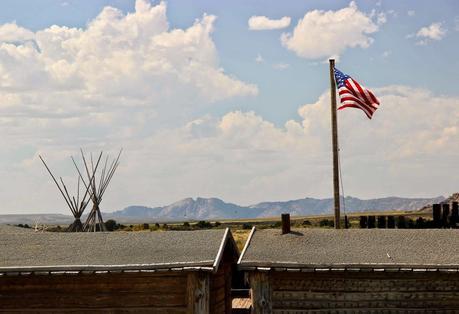
Devil's Gate in 2014.
In the mid-1800s, hundreds of thousands of gold-seekers, pioneers, pilgrims and other dreamers took the Oregon Trail west. They followed the valley of the blessed Sweetwater River across what is now central Wyoming, finding grass and drinkable water in an arid land of alkaline streams. Several miles upstream from its confluence with the North Platte, the Sweetwater cut through a granite ridge via a gap impassable to wagons, hand carts and other vehicles of the day. Travelers christened it “Devil’s Gate” and made a short detour to the south. Why didn’t the river go that way? It would have been so much easier!
Western part of original Oregon Trail; red arrow points to Devil’s Gate. Map by Ezra Meeker.

Devil's Gate in 1870, William Henry Jackson; Public Domain.
“This gap is truly wonderful, being a space not over twenty yards wide and about five hundred feet high, having very much the appearance of being chiseled out by the hand of man rather then [sic] the work of nature.” Osborne Cross, 1849 (diary entry)Devil’s Gate isn't as odd as it might seem. In Wyoming, it’s not unusual for rivers to cross ridges and even entire mountain ranges. We have lots of superimposed drainages.
superimposed drainage: A naturally evolved drainage system that became established on a preexisting surface, now eroded, and whose course is unrelated to the present underlying geological structure. (McGraw-Hill Science & Technology Dictionary 2003)Devil's Gate is where the superimposed Sweetwater River crosses a granite ridge at the east end of the Sweetwater Rocks. These were the high peaks of the Granite Mountains before the range collapsed (see this post).

From Google Earth; labels added. Click on image for a better view.
Roughly five million years ago, Wyoming mountain ranges were largely buried. Streams flowed on the surface above, oblivious to underlying topography. Then widespread erosion set in and streams were lowered down onto whatever was below -- in some cases rock ridges or mountain ranges. They had no “choice” but to cut through. For more about cycles of regional burial and exhumation, see this recent post.

Block diagrams by Brainerd Mears, Jr., after originals by Samuel H. Knight (Regional Geomorphology class, University of Wyoming, 1984).
The ridge crossed by the Sweetwater River is mainly Precambrian granite, estimated to be 1.8 billion years old (Lageson and Spearing 1988). There also are occasional dikes of darker rock, for example in the area of Devil’s Gate.
"Granite with dikes of dark intrusive rock (Devil’s Gate) ... June 1922." WT Lee, USGS Photographic Library [arrows added].

Devil’s Gate and dikes, August 2014; click on image to view.
The interpretive sign at the end of the trail explains that “volcanic activity split the granite ... and forced molten basalt into the fissure”. But the dikes more likely are diabase, the shallow intrusive equivalent of basalt (see Granite Mountains by the Wyoming Geological Survey). They're Precambrian in age, truncated before deposition of Cambrian sandstones (Love 1970). The diabase is softer than the surrounding granite, so the Sweetwater River was able to cut through the ridge via a conveniently-located dike.
Start of trail to Devil's Gate; Split Rock in distance.
Devil’s Gate is a National Historical Site, part of the California National Historical Trail. The gap is on public land (Bureau of Land Management) and can be reached by a short trail that crosses the Sun Ranch, now owned by the LDS Church. The Church bought the ranch to develop a site memorializing an ill-fated Mormon party that may have sought refuge nearby. It also tried to buy adjacent public land through Federal legislation (public land normally isn't for sale). This stirred up quite a bit of concern and protest among Wyoming citizens. The effort failed for good when several Indian groups also expressed interest in purchasing sacred sites. Instead, an agreement was reached which includes access across the ranch. See this site for more information.
The hike to Devil's Gate.
Sources (in addition to links in post)Blackstone, DL. 1988. Traveler’s guide to the geology of Wyoming, 2nd ed. Geological Survey of Wyoming Bulletin 67.Lageson, DR and Spearing, DR. 1988. Roadside geology of Wyoming. Missoula, MT: Mountain Press Publishing Co.Love, JD. 1970. Cenozoic geology of the Granite Mountains area, central Wyoming. USGS Professional Paper 495-C.
